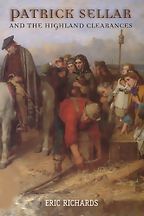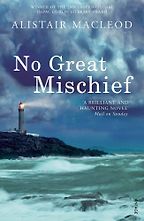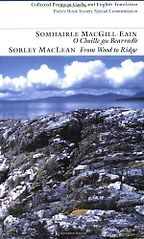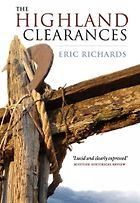You’ve chosen five books about the Highland clearances. What got you interested int he subject in the first place?
I grew up in Argyll, in a little place called Duror, south of Ballachulish. The first I heard of the Highland clearances was from my grandfather – my mother’s father, whose name was John Cameron. He lived with us when I was a child, and died when I was 13 or 14. I was interested in history at school, and went on to study it at university, but what got me thinking about Highland history was reading John Prebble’s book “Glencoe: The Story of the Massacre.” That was what made me think for the first time that there was a history of the Highlands. Because before then I had tended to think of history as being the foreign policy of Queen Elizabeth I, the Reformation, or some such thing. But when I went to university there was very little Scottish history included in the degree, and what little there was seemed to me to be coming from a very different perspective to that of my grandfather. So I went on to Edinburgh to do a PhD, and that PhD evolved into my book The Making of the Crofting Community. What I was trying to demonstrate was that you could write a history of the Highland clearances and subsequent events that was both academically reputable – in that it was well-sourced and based on research and archives – and also truer, as I thought, anyway, to the standpoint of the people in the Highlands than a lot of other academic history.
What areas of the Highlands were the worst affected?
Well the area that everybody has heard about is Sutherland. But in some ways what happened in Sutherland was quite untypical. The clearances in Sutherland were conducted on behalf of the Sutherland family, which was at that time one of the wealthiest, if not the wealthiest, family in the whole of the United Kingdom. It was meant to result in the complete redevelopment of the Sutherland economy by giving over the interior to sheep farmers and settling the people cleared on the coast, where they would become fishermen and the like. It didn’t work and became quite notorious, partly because of the eminence of the landowning family involved.
But while the clearances in Sutherland were at their height in the second decade of the 19th century, around 1815, the clearances of the late 1840s and early 1850s – in places like South Uist and Barra – were far worse in terms of sheer brutality. By that point the landowners had lost all conviction that there was any future for the people they were removing and they were just shovelling them out.
The landlord of Barra, South Uist and Benbecula was a man called John Gordon of Cluny, who had bought the estate from the Clanranalds when they went bust in the 1830s. Gordon just wanted rid of people, and there was famine in the Highlands, just as in Ireland, in the 1840s, so people were leaving in appalling conditions and being shipped at his expense to Canada and dumped on the quayside. Canadian immigration officials, who were at that time dealing with the refugees from the Irish famine, said they’d never seen people in a worse state than the folk who came from the Uists. Some of them almost literally had no clothes.
This must have had a huge effect on the Scottish culture and Gaelic language.
Well, it’s bound up with the much wider disintegration of the traditional society of the Highlands. There were all sorts of external forces operating on clanship long before the 1745 Jacobite rebellion, but with the defeat at Culloden in 1746 all of that accelerated, so you had the commercialization of agriculture and of the land structure, the former chieftains turned into landlords, and the whole society went into disintegration. So apart from the fact that people are being removed through brutality and hardship, there was a huge sense of cultural disorientation.
One of the reasons that I recommended a couple of books by Eric Richards is that Richards is very good at highlighting the fact that there was nothing unique about this. That it was a manifestation, in the context of the Highlands and Islands, of something that was happening at the same time and has happened subsequently in many other parts of the world: the collision between modern, commercial capitalism and more traditional society.
His book Patrick Sellar and the Highland Clearances is about a fascinating character. Sellar was one of the factors of the Sutherland estate and a sheep farmer himself. Sellar had a very well worked-out view as to what he was about. His justification was that he was bringing civilization and enlightenment to where previously there had only been darkness and barbarity. And that was exactly what people thought who were taking the British Empire into Africa, or American civilization across the prairies.
Eric Richards’ book publishes letters from Sellar which are full of idealism – he seems very proud of what he’s doing.
Sellar made quite a bit of the fact that one of his own forebears had been a small crofter or peasant farmer in Morayshire and had been removed from the land. Sellar was a lawyer by profession and thought that he had, as it were, risen into the professional class as a result of what had happened to his grandfather or great-grandfather – that he had been kicked out of his croft. He thought, genuinely, I believe, that while what was happening to the people he was evicting might be harsh and horrible, they, or if not them then certainly their children and grandchildren, would actually thank him for it – for having spared them the horrors of continuing to be crofters in Sutherland!
There’s a huge Scottish diaspora as a result of the clearances. You’ve recommended Marjory Harper’s book Adventurers and Exiles: The Great Scottish Exodus.
To begin with, when the clearances started, many people did want to leave. They saw America as a land of liberty and an opportunity to obtain land, and, as their Gaelic songs emphasized endlessly, there were no landlords. America was a place that people wanted to get to. But up until about 1820, the landlords wanted to keep the people in the area; to remove them from the inland places being made over to the sheep farmers, but establish them on smallholdings on the coast. That was the beginnings of the crofting system. Crofts were deliberately made small so that a family couldn’t make a living from agriculture alone and would have to do other things. I mentioned fishing, but much more important on the West Coast and in the Hebrides was the kelp industry.
The kelp industry depended on the manufacture of a kind of crude industrial alkali from seaweed, much in demand for the manufacturing industry then developing in the south. But the industry collapsed in the period 1815-1820, and after that crofting was seen by the landlords who’d created it as having outlived its usefulness. People were turfed back on to their tiny bits of land and the only crop that could grow on the crofts in sufficient quantities to feed a family was potatoes. Then came the potato blight in the 1840s and the famine. By that point the landowners were just wanting to get rid of people, and they began shipping them overseas.
At the time there was a lot of timber being imported into the UK from Canada. The timber ships were always pretty rundown, and when they emptied out the hold they would put a couple of crude decks inside, and people were crossing the ocean in the holds of these ships. These voyages could last two or even three months. When the weather was bad the hatches were battened down and it was the perfect breeding ground for cholera and typhoid and all the rest. So it’s not a happy story of everybody sailing off to America and living happily ever after; an awful lot of them never made it to America in the first place.
Tell us about the Alistair McLeod book, No Great Mischief.
That’s a wonderful book. Alistair McLeod hasn’t written an awful lot; that novel is his most recent production, and he has a collection of short stories, “Island”, that is in some ways even better.
The novel’s about a family in Canada today and how they connect with their past and their heritage, and their Highland background. It’s not setting out consciously to explore all this in any explicit way, it’s just the background to the novel, but it comes at the whole theme in a way no purely factual book could. It’s won a lot of awards and it’s a terrific book.
You’ve recommended another piece of creative writing: Sorley Maclean’s “Hallaig”. Sorley Maclean was originally a Gaelic poet, is that right?
He was entirely a Gaelic poet. The book’s entitled Collected Works in Gaelic and English, but he never wrote a poem in English: he wrote all his poetry in Gaelic and then translated it. He grew up in Raasay, a little island just off the coast of Skye, and I’d say he’s seen as the greatest Gaelic poet of the 20th century. One person who has written most perceptively about “Hallaig” is Seamus Heaney, who made his own translation. As Heaney indicated, in some ways the poem is quite straightforward and simple.
The township of Hallaig was completely cleared in the early 1850s and most of the inhabitants were shipped to Australia. The poem is an evocation of the people who were there – particularly the young girls, as they are walking into the township, who begin as birch trees and are transformed: “The men lying on the green/At the end of every house that was,/The girls a wood of birches/Straight their backs, bent their heads.”
It’s not just a lamentation for the desolate nature of the place, although it is partly that – it’s also an evocation of what the Highlands might have been without what, in the English translation, is described as “the heartache of the tale”.
Interview by Cal Flyn, Deputy Editor
September 30, 2009
Five Books aims to keep its book recommendations and interviews up to date. If you are the interviewee and would like to update your choice of books (or even just what you say about them) please email us at [email protected]
Five Books interviews are expensive to produce. If you've enjoyed this interview, please support us by donating a small amount.










